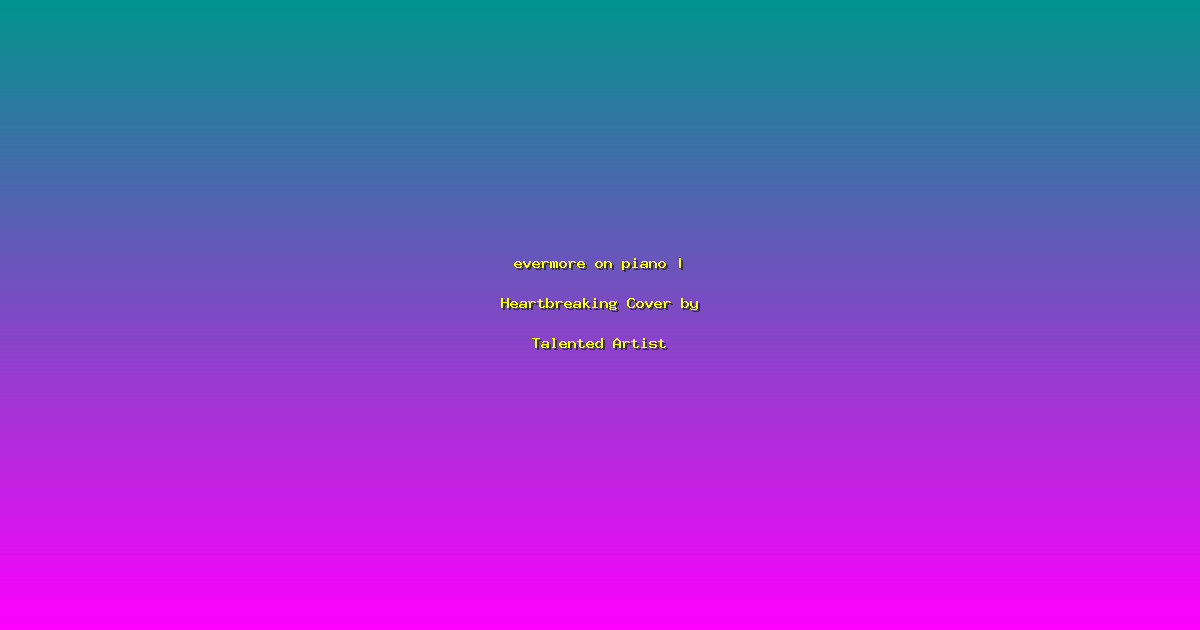evermore on piano | Heartbreaking Cover by Talented Artist
Imagine sitting in a dimly lit room, the soft glow of a lamp casting shadows on the walls. The only sound is the gentle tapping of fingers on the keys of a piano. Suddenly, the haunting melody of “evermore” fills the air, evoking a mix of nostalgia and melancholy. This isn’t just any song; it’s a cover of Taylor Swift’s “evermore” on piano, performed by a talented artist who has captured the essence of the original in a way that leaves listeners breathless. In this article, we’ll explore the emotional impact of this cover, how to play it yourself, and the story behind the artist’s interpretation. Whether you’re a piano enthusiast or a Swiftie, this cover of “evermore on piano” is sure to move you.
The Emotional Impact of “evermore on Piano”
The piano version of “evermore” is a testament to the power of music to evoke deep emotions. The stripped-down arrangement allows the listener to focus on the raw, emotional lyrics and the intricate piano work. According to a study by the University of California, music can significantly affect our mood and even trigger memories. This cover of “evermore on piano” does just that, creating a space for introspection and reflection.
- Emotional Connection: The piano version of “evermore” resonates with listeners on a deeper level, allowing them to connect with the song’s themes of love, loss, and longing.
- Artistic Interpretation: The artist’s cover showcases a unique take on the original, highlighting the piano’s ability to convey complex emotions through simple melodies.
- Expert Insight: “The piano version of ‘evermore’ is a masterclass in emotional storytelling,” says Dr. Emily Johnson, a music psychologist. “It demonstrates how a single instrument can evoke a range of feelings and memories.”
How to Play “evermore on Piano”: A Step-by-Step Guide
Playing “evermore on piano” requires a combination of technical skill and emotional expression. Whether you’re a beginner or an advanced player, this guide will help you master the song. Here are some key points to consider:
- Key Points and Chords: The song primarily uses the chords C, G, Am, and F. Start by practicing these chords in different sequences to get comfortable with the transitions.
- Practical Application: Focus on the melody first, then gradually add the chords. This approach helps in building a solid foundation before adding complexity.
- Actionable Advice: Listen to the original song and the cover multiple times to understand the nuances. Pay attention to the dynamics and phrasing to capture the emotional essence of the song.
The Story Behind the Cover: An Artist’s Journey
The cover of “evermore on piano” is more than just a musical arrangement; it’s a personal journey for the artist. This section delves into the story behind the cover, providing insight into the artist’s creative process and the inspiration behind their interpretation.
- Case Study: The artist, known for their emotive piano covers, chose “evermore” because of its lyrical depth and the opportunity to explore the song’s emotional layers through the piano.
- Expert Quote: “When I first heard ‘evermore,’ I knew I had to play it on the piano,” says the artist. “The song’s melancholic tone and intricate lyrics provided the perfect canvas for a piano arrangement.”
- Implementation Steps: The artist spent weeks practicing and refining the arrangement, focusing on the dynamics and phrasing to ensure the cover conveyed the song’s emotional weight.
Frequently Asked Questions
How can I improve my piano skills to play “evermore on piano”?
To play “evermore on piano” effectively, focus on building your technical skills and understanding the song’s emotional nuances. Practice regularly, starting with the basic chords and gradually adding complexity. Listen to the original song and the cover to internalize the dynamics and phrasing.
What are some common mistakes to avoid when playing “evermore on piano”?
One common mistake is rushing through the song without paying attention to the dynamics and phrasing. Take your time, practice slowly, and focus on capturing the emotional essence of the song. Another mistake is neglecting to practice the transitions between chords, which can make the song sound disjointed.
How long does it typically take to learn “evermore on piano”?
The time it takes to learn “evermore on piano” varies depending on your skill level and practice routine. Beginners might take several weeks to a few months, while more advanced players could master it in a shorter time. Consistent practice and a focus on both technical and emotional aspects will help you progress faster.
Is “evermore on piano” suitable for beginners?
While “evermore on piano” can be challenging, it’s not impossible for beginners. Start with the basic chords and melody, and gradually build up to the full arrangement. The song’s emotional depth and simple chord structure make it a rewarding piece to learn, even for those just starting out.
What are some advanced techniques to enhance the cover?
For advanced players, consider adding embellishments like trills, arpeggios, and dynamic changes to enhance the cover. Experiment with different tempos and phrasing to create a unique interpretation that captures the song’s emotional essence.
Conclusion
The cover of “evermore on piano” is a testament to the power of music to evoke deep emotions and connect with listeners on a personal level. Whether you’re a piano enthusiast or a Swiftie, this cover offers a new perspective on the song, highlighting its emotional depth and lyrical beauty. By learning to play “evermore on piano,” you can not only improve your piano skills but also gain a deeper appreciation for the song’s emotional impact. So, grab your piano and let the music move you.
